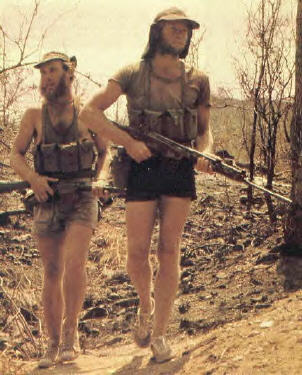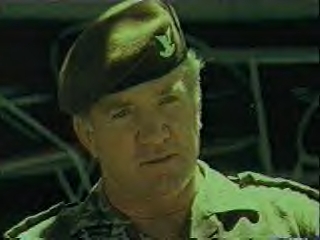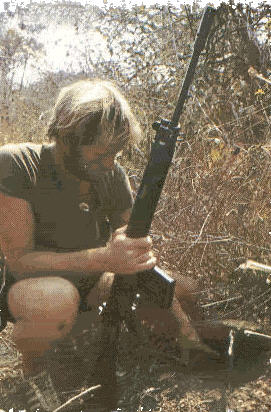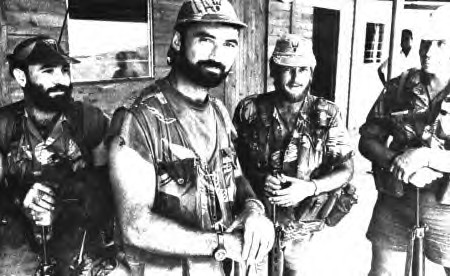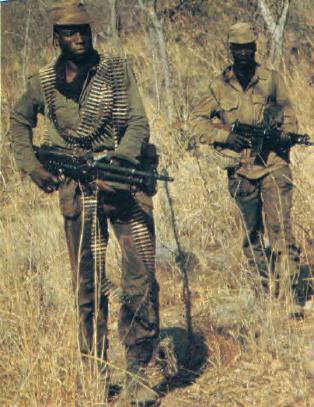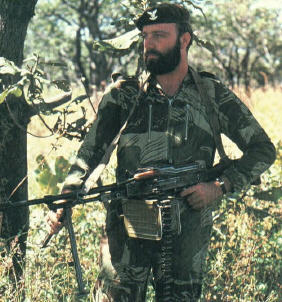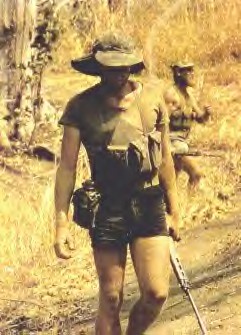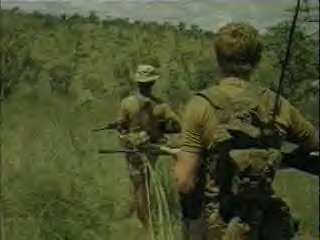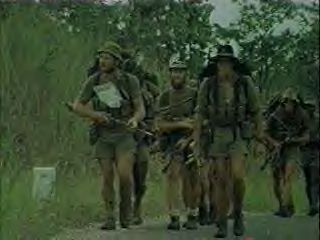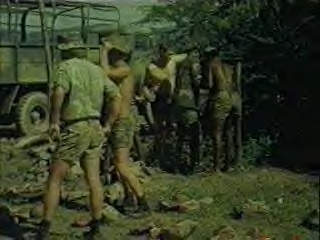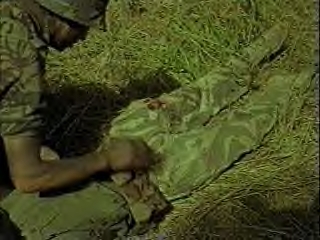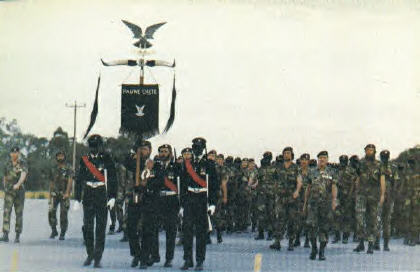|
|
Selous Scouts |
|
|
||||||||||||||||
|
|
The initial Selous Scouts were formed on 1st January 1964 as an armoured car regiment of the Central African Federation of Southern Rhodesia (former Rhodesia, now Zimbabwe), Northern Rhodesia (now Zambia) and Nyasaland (now Malawi), and were named after Frederick Courtney Selous (1851-1917) a famous hunter and friend of Cecil Rhodes. After the political failure of the Federation, the regiment was disbandoned within the same year of its formation. |
|
|
||||||||||||||||||||||||||||
|
|
||||||||||||||||||||
|
|
The Selous Scouts were recruited from volunteers between 24 and 32 years of age, with the highest motivation, tough guts, loyalty, deep
professionalism, maturity and intelligence. A thorough understanding of the meaning of responsibility was equaly as important as self-discipline. Being a loner and able to survive the rigours of the african bush,
and on the other extreme, being able to fully function as a team player was one of the do-or-die criterias that weeded out the rest from the best. Before the initial training programm started, the volunteers had
to undergo a severe selection camp that lasted for 18 days. In the 7 years of existence of this elite unit only 15 per cent of the volunteers made it past the selection stage and were awarded membership into the
ranks of the Scouts. The selection process was conducted at camp Wafa Wafa, on the shores of Lake Kariba in the north of Rhodesia. Wafa Wafa, coming from the Shona language basically meaning
-“WHO DIES DIES, WHO STAYS BEHIND STAYS BEHIND”. The selection course of the Selous Scouts built up on what Reid Daly underwent as a British SAS operator, but was taken much farther than that. No provisons were
issued for the first five days of the course. The recruits had to live off the land. Then, on the fifth day, they usually were given a baboon carcass that was left to rot in the sun for three days. The recruits
had to prepare the maggot rotten meat and eat it. For the remaining 13 days they were given rations consisting of only one sixth of a mans usual daily intake. Recruits were forced to make the bush their own habitat.
Eating all kinds of animals and - in times of water shortage - even drink the water from the stomachs of dead animals. Later, in actual combat situations, Scouts were forbidden to shoot animals. During most
selection courses 80 per cent of recruits dropped out after just two days. |
|
|
|
|
The infamouse Baboon |
|
|
Reid Daly´s intention was to completely break a man in order to built him up again from scratch, according to the needs and requirements of the
Selous Scouts. Now training as a Scout could start. Infiltration techniques, weapon handling, parachute training (HiLo) and all other means of warfare of a Special Force Operator were trained. Special attention was
given to perfectly operating as so-called “Pseudo-Groups”. Selous Scouts operating in small teams (2-3 operators) behind enemy lines, seeming to be terrorists themselfes, therefore gathering vital information.
These units were completely self-sufficient, living off the land and re-supplying themselfes with arms and ammunition of terrorists killed. For that purpose every member of the Selous Scouts had to be fluent in at
least one tribal dialect or language. |
|
|
|
|
The combat strength of the Selous Scouts averaged at around 700 members, reaching its highest level in 1977 with almost 1000. As a regiment purely made up of volunteers, the Selous Scouts were a true bi-racial unit. More than 80% of its members were black. |
|
|
|
|
In 1978 it was estimated that some 12.500 cadres of the ZAP were fighting against the Rhodesian Army. Independant sources, mainly UN officials and organisations supporting the cause of ZANU/PF, estimated the casualties of ZAP amounting to one third in fatalities (kia) of the total of troops. Until the end of hostilities this number has risen considerably - but due to censorship imposed by ZANU/PF, the real numbers will never be known. According to the then Government of Rhodesia, the Selous Scouts accounted for 68% of those killings with only 36 own casualties - hence having been the most effective Special Force in history. |
|
|
||||||||||||||||||||||||
|
|
Although there were many raids conducted by the Selous Scouts, the most talked about one will always be Operation Eland, carried out in August 1976 against a ZANLA guerrilla camp in Pungwe/Nyadzonya in Mozambique. 72 Selous Scouts, amongst them a handful of Recces from South Africa, mounted 10 Unimogs and three Ferret armoured cars and drove calmly into the 5000 strong camp of ZANLA rebels on the banks of the river Nyadzonya. As soon as the enemy realized who they had welcomed, the Scouts opened fire with everything they had - killing 1200 ZANLA troops with only five own soldiers wounded. |
|
|
||||||||||||||||||||||||||||||||||||||||||||||||||||||||||||||||||||||||||||||||||||||||||||||||||||||||||||||||||||||||||||||||||||||||||||||||||||||||||||||||||||||||||||||||||||||||||||||||||||||||||||||||||||||||||||||||||||||||||||||||||||
|
|
|
|
|
The end came with the end of Rhodesia. In 1978, white rule came to an end with the election of Bishop Abel Muzorewa as the first black
Prime Minister, and the name Rhodesia was changed to “Zimbabwe-Rhodesia”. However, the outside powers Soviet Union, China, Tanzania, Zambia and others who had assisted and funded the guerrilla groups, did not
agree to this compromise. Bishop Muzorewa was considered not black and red enough, so the guerrilla war continued after his election. With both sides becoming increasingly exhausted by the war, both physically and
financially, the Zimbabwe-Rhodesia government agreed to a peace conference in London, which eventually led to a cease-fire and elections. However, despite well intentioned British army observers, these elections
were nowhere near anything that could have been called free and fair. In many tribal areas terrorist gangs intimidated and forced the local population to vote for ZANU/PF and so the leader of ZANU/PF Robert Mugabe
was elected Prime Minister and the nation was renamed Zimbabwe. On 18th April 1980, soon after ZANU/PF taking over the powers in the former Rhodesia, the Selous Scouts were disbanded without an official
ceremonie by an Army HQ order. Already back in 1976, when operators of the South African Reconnaissance Commandos were fighting alongside the Scouts in Mozambique, talks commenced about incorporating
the Selous Scouts into the SADF should Rhodesia fall. This now took place in 1980 when most of the former Selous Scouts left Zimbabwe and joined the famous Recces. A lot has been written about the whereabouts of
the Scouts within the Recces, but I trust the story of Reid Daly and Peter Stiff the most, which says that the former Rhodesian SAS fathered 6-Reconnaissance Commando and the Selous Scouts formed 7-Reconnaissance
Commando (soon to be changed into 3-Recces) in Phalaborwa, northern Province. Construction on this brand new army base commenced as early as 1978, when it became evident that the Selous Scouts had no place in the
future former Rhodesia. Still in 1980, 3-Recce Commando and 5-Recce Commando from Dukuduku base in northern Natal, were merged to form the new 5-Reconnaissance Regiment, stationed at Phalaborwa. The Selous Scouts´ regimental artifacts were smuggled out of Zimbabwe and taken to Phalaborwa, were they became the traditional foundation of 5-Reconnaissance Regiment. After the 1994 elections in
South Africa, the regimental standard was hastily retrieved from the base and handed back to the founder of the Selous Scouts, Lieutenant-Colonel Ron Reid Daly. Unfortunately, the integration of the
Selous Scouts into the SADF was not a smooth transaction. The former Rhodesian soldiers came from a British background, speaking English and were used to completely different drills and traditions than their South
African counterparts. The South Africans, on the other hand, still felt uneasy with everything British due to the Boer War. The language in the ranks of the SADF was Afrikaans, not English, and following of the
Dutch Reformed Church was a must. Although very close neighbours and partners in combat, the little things of everyday´s life made it difficult for many of the former Selous Scouts to stay in the ranks of the SADF after
the first year. Most of the members that left went to join the mercenary agency Security Services Transkei Pty Ltd of their former Commander Lieutenant-Colonel Ron Reid Daly. Others joined the Transkei
Defence Force (TDF) and only very few stayed on to serve in the SADF. |
|
|
|
|
“Rededication Parade” on 17th February 1979 at the homebase of the Selous Scouts, Andre Rabie Barracks, Salisbury |
|
|
||||||||||||||||||||||||||||||||
